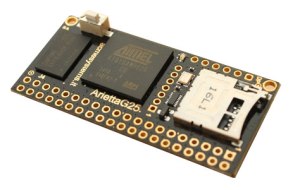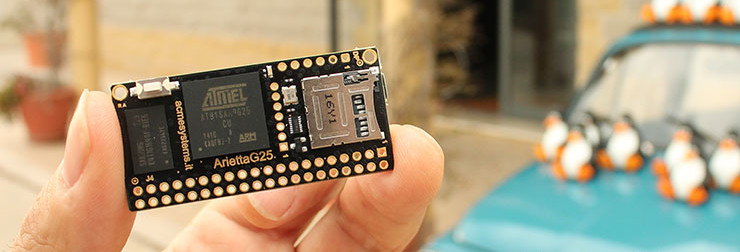
This tidy little ARM board is the Arietta G25. It’s based around an AT91SAM9G25 which is an ARM9 chip running at 400MHz. Paired with the DDR2 RAM (in 128 or 256 meg options) to the left, the board runs Linux and runs it well. After the break you can see the obligatory running of Doom. But in this case it doesn’t just run a demo, but is playable from momentary push buttons on a breadboard (props to the Arietta team for using wire wrap for that setup).
See the vertical row of pads between the processor and the SD card slot? That’s a breakout header designed to accept a WiFi module. In at €20-30 based on your RAM choice and just €7 for the WiFi module this board is certainly a contender for any embedded Linux projects. But it does have us wondering, should be thinking of these as ARM boards, or forget the low-level development and just think of them as a Linux machines with plenty of GPIO available?
The 20×2 pin header breaks out a lot of the SAM9’s features. We really like the interactive pinout posted for this device. For instance, there are three sets of USB host lines available. But you’ll want to click on each to see that one set is in use for the SD card, and another is used by the WiFi module. The documentation that has been posted for the Arietta G25 is one of its strongest point. Nice work there!
https://www.youtube.com/watch?v=lluFY78mW4U
[Thanks Michele]
















I a couple of the older, and slightly less featureful, Aria G25s. They are great boards and Acme does a great job of providing support, and accessories for these amazing little boards. The Aria G25 is more suited to production, since it is surface mountable, etc
The Arietta G25’s are wonderful for hackers, small, easy to interface with, has the built in microSD and optional wifi adaptor. It is great for prototyping wearables, or for adding interactivity where space is limited.
The only downside is shipping. Since they have to come from Italy, it can be quire ear if you just want one or two units. I am hoping they get a US reseller soon
http://microcontrollershop.com/ is the US reseller for this product
They sell the Aria not the Arietta. At least according to their search box
http://microcontrollershop.com/product_info.php?products_id=7011
Excellent, glad to see it is finally there. It wasn’t when I wrote my comment
We sell this product in Canada. We can ship to USA.
Visit: http://voltatek.com/en/97-arietta
In case someone is wondering, how the bottom side looks like (took me a while to find), it is here, alongside some power consumption measurements: http://www.robertoasquini.com/?p=148
Thanks for sharing, I was wondering where most of the passive components were.
But it seems like you on Hackaday missed their preorder at the beginning of 2014, when a 128MB Arietta board was only about 10€ (+ tax and shipping) :-D
Impressive. I’m tempted to make a impulsive purchase.
Gumstix has been doing this for YEARS. This leaves me wondering why this article makes the G25 sound so new.
Umm, because Gumstix has that fine pitch connector? :P This looks to be made easier to interface with.
It looks like the Gumstix boards are about an order of magnitude more expensive to me. Athough they are more powerful, they do not offer dirt cheap lower end models like this, or I am missing something?
true. i see this as a cheaper gumstick or a smaller beaglebone.
JTAG not broken out, so that limits the type of debugging you can do.
Since it’s running linux you don’t need JTAG to debug your user programs
If you are debugging the kernel you are probably not using this board
that is overly optimistic.
having a serial console is very useful on any of those boards, no matter what. there is always the time where your usb do not work and you have no lcd header or network parts nearby. or maybe you re having trouble setting up those peripherals.
The Aria G25 has a serial console, and am about as certain as I can be the Arietta does too
Yes there is a debug output on the Arietta. Its called the “DPI” I am using it since years with the old Fox board and the Aria. This little thing is very reliable and it can be used to program 4D Systems Displays too. Bought mine at https://www.tigal.com/product/1846
JTAG debugging is a lot more capable than serial console as it is hardware debugger vs software routines to print messages/monitor program. You can still go in to take a look at the peripherals/stack/memory even when the processor blows up the stacks or crashed. Not having it means you play in a Linux sandbox and not use this board for bare metal work.
Assuming you already have fully debugged kernel drivers for the I/O and they are acceptable performance, you can work in user space. If you have to debug/modify/write kernel drivers, you would want to have JTAG for debugging.
Great, I like it. It’s cheap and very small, like a micro controller BUT it’s include a memory management unit, which usual micro controller lacks of.
I like the idea of programming it on bare metal, with a Forth inspired command line (FICL) interpreter+ usb fat + lwip + rtos, kind of micro os… (it did almost work on the stm32discovery, damned mallocs !)
micropython
node.js blows away python
Once these start to come with a IO controller like the Beaglebone and the IO controller has an easy, documented programming interface we will see the next step. Who wants to be busy waiting in Linux user space while trying to control pins for, say, the DHT22, not me.
What would be cool is a dual core ARM, where Linux is running on one core, and the other can be used for low-level control.
this already exists. one really ubitous example is with the beaglebone black, which has a “programmable realtime unit”
The PRU is a bit simple. I was thinking of another ARM Cortex.
So you want one of the newer OMAP chips from TI. OMAP 4 has 2 Cortex M3 cores and OMAP 5 has 2 Cortex M4 cores. Plus their main >1GHz Cortex A9/dual A15 respectively and video cores.
From what I can find the only devboard with one of those chips is PandaBoard.
this is why they invented kernel drivers
Love the use of a VT100 for the terminal picture :)
strap an atmega chip interface to it and make it easy to use and people will buy it, lots of people want a simple gpio interface from a recognisable OS as well as the baremetal crowd who don’t mind going it alone, not wanting to stir a debate on which chip, arduino IDE is extremely well supported so it would seem like a no brainer (for programming), well documented methods for talking to spi, i2c, etc. and you’re onto a real winner. Then again, strap a decent mcu interface to a quad core arm board and you’re onto a winner too :D
arduino was designed to run on tiny MCUs with miniscule resources, running it on hardware like this is a total waste. arduino has no support for threads or tasks or queues or memory management or even non-blocking APIs so it’s unsuitable for the kinds of applications that this board will support.
And those “well documented methods for talking to spi, i2c, etc” are brain-dead and unusable in the modern asynchronous programming style that is becoming the norm (see node.js for the RIGHT way to program event handling).
With the tremendous power available on these modern MCUs, the tendancy to use broken old software models is a big step backwards.
good to know the sam9g25 can run doom and display it on an spi lcd. I was planning on doing just that with this http://armdevs.com/WiFiG25.html
Wish shipping wasn’t so expensive :/
MicrocontrollerShop.com is the retailer in the US. They don’t sell the Arietta yet, but if enough people asked I am sure the will add it.
We are a new reseller in Canada. We can ship to USA. Please visit us: http://voltatek.com/en/97-arietta
Thanks!
Anybody know if the wifi supports Monitor Mode and Injection?
We sell also Arietta and accessories
https://store.open-electronics.org/index.php?route=product/search&filter_tag=arietta
We sell (not only) Arietta G25 and some accessories (increasing daily) in Germany